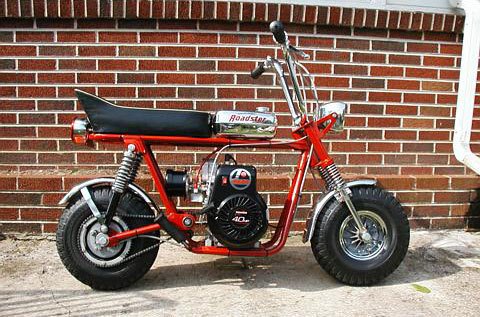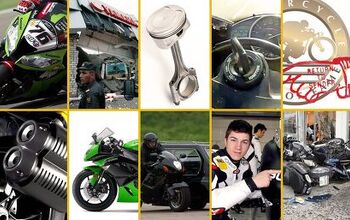Top Ten Defunct Motorcycle Manufacturers
For the last 40-some years motorcycle manufacturers have enjoyed an era of relative stability. The Big Four Japanese (Honda, Kawasaki, Suzuki, Yamaha), Harley-Davidson and BMW remain unremitting and seemingly indestructible.
Using history as an indicator, however, even these steadfast OEMs could one day topple and fade into obscurity (H-D was close to expiring in the early ’80s). Motorcycle companies such as Ariel, BSA and NSU – once world renowned, championship winners and sellers of hundreds of thousands if not millions of models – eventually succumbed to demise more or less due to increased competition, financial missteps or consolidation.
Recently, companies such as Indian, Norton, Triumph, et. al., have been revived, broadening the motorcycle spectrum but also discluding them from this list. The 10 we selected represent a range of OEMs chosen for various reasons including longevity, units sold, historical significance, country of origin and sentimentality. Beware, your list may differ from ours.
10. Rupp
Many childhood glory days of the 1960s and 1970s were spent aboard Rupp minibikes. In 1959 Mickey Rupp founded the Rupp Manufacturing Company in Mansfield, OH, where he and eight employees built Dart Karts. The next year he expanded into minbikes producing 1,000 in 1960. At the company’s height it was manufacturing upwards of 75,000 minibikes per year along with scores of Sno-Sport snowmobiles, ATVs and go-karts. Sadly, Rupp was forced to sell a controlling interest in his business in 1973 and five years later there was no saving the Rupp company, 1978 being its last model year. Motorcyclists and non-motorcyclists alike have an affinity for their childhood Rupps, increasing the collectable value of the various models produced. Rupp minibike models included the following: TT500, Roadster, Roadster2, Scrambler, Black Widow, Enduro, Chopper and a three-wheeler called the Centaur.
9. NSU
NSU got its start manufacturing knitting machines in 1873, expanded to bicycle production in 1886 and then motorcycles in 1901. The factory was severely damaged in WWII but by 1955 had rebounded to become the world’s largest motorcycle manufacturer producing upwards of 350,000 bikes that year.
Prior to that, in 1951, NSU set the motorcycle speed record of 180 mph on a 500cc turbocharged model. NSU also held speed records in various classes from 50cc to 500cc. In 1956, Whilhelm Herz broke the 200 mph barrier aboard a turbocharged 500cc NSU streamliner. NSU also won multiple Grand Prix World Championships in the 125cc and 250cc classes between 1953 and 1955 on machines such as the replica pictured above that privateer Hermann-Paul Muller piloted to the 1955 250cc world championship. In 1969 NSU was merged into the Volkswagen Group and effectively discontinued.
8. Laverda
Laverda cut its teeth with small-displacement, single-cylinder two-strokes but attracted international attention when it announced at the 1967 Milan show that it would be constructing a big bike powered by a 650cc parallel-Twin. In 1970 Laverda won its first production bike endurance race and in 1971 the SFC was launched. The SFC was known to be one of the fastest street-legal machines of the early ’70s. During its six-year production run Laverda only constructed 549 SFC models, making the bike rare today. All of its success couldn’t keep Laverda alive and in 1985 the company closed up shop. Since then there’s been multiple Laverda rebirths but thus far nothing has stuck. Piaggio acquired the rights to Laverda when it bought Aprilia in 2004 but has expressed no intention to develop the brand.
7. Bultaco
In a very Ferrari vs Lamborghini way, Bultaco was born from the scorn of rejection. When in 1958 Montesa removed itself from Grand Prix competition one of its founding members, Francisco “Paco” Bulto, left to form his own motorcycle company. The Bultaco name came by way of suggestion from Bulto’s business associate and top road racer, Johnny Grace, to combine Francisco’s last name, Bulto, with his nickname, Paco.
Although the company produced both on- and off-road bikes (winner of three consecutive 50cc Grand Prix world titles) Bultaco is best known for its trials models, especially the Sherpa T. The GOAT of Trials, Sammy Miller, road the Sherpa to a win in its inaugural race in 1965 and finished the year by taking the British Trials Championship. Bultaco went on to dominate Trials competitions for the next 15 years. But like the rest of the OEMs in this list, no matter the success, continuity wasn’t in the cards for Bultaco, and it ceased production first in 1979, then, after a brief reprise from 1980 to 1983, closed its doors again permanently.
6. Excelsior-Henderson
Bicycle icon and AMA Hall of Famer, Ignaz Schwinn, purchased Excelsior (not to be confused with the British and German brands of the same name) in 1911. Six years later he purchased the Henderson Motorcycle Co. Within the next decade Excelsior-Henderson was the third largest U.S. motorcycle manufacturer behind Indian and Harley-Davidson. The Great Depression convinced Schwinn to shutter his motorcycle division in 1931.
Around 62 years later Dan Hanlon re-established the Excelsior-Henderson marque. A significant investment was made from various sources, and a new factory built in Belle Plain, MN. After producing upwards of 2,000 models over the course of two years, however, the company ran dry of capital and ceased operations.
5. Ariel
Like many defunct British motorcycle OEMs, Ariel was at one time a technological innovator. Legendary motorcycle designer Edward Turner designed the original Square Four for Ariel after joining the company in 1928. The unique engine incorporated a chain-driven overhead camshaft with two 180-degree cranks geared together and featured a unit transmission. The original model was a two-pipe design until the 1953 Mark II model switched to the four-pipe design picture above. Ariel was absorbed by BSA in 1958 and, as with most UK motorcycle manufacturers, came to untimely end in the latter part of the 1960’s decade.
4. Flying Merkel
Although rare, it’s hard to attend a vintage motorcycle show and not see a Flying Merkel. Designed and built by AMA Hall-of-Famer, Joseph Merkel, the Flying Merkel was an early leader of American motorcycle innovation, winning numerous victories circa 1910. Merkel utilized mono-shock rear suspension when most bikes had no suspension. And while the front appeared to be an unsprung trussed fork, it was actually telescopic, using dual coil springs. Sold to Miami Cycle Manufacturing in 1911, the brand continued until the onset of WWI, after which it did not return, the models produced becoming fodder for future collectors and restorers.
3. BSA
Prior to WWII the Birmingham Small Arms Company (BSA) was England’s largest motorcycle manufacturer. Post WWII and BSA was, for a period of time, the largest motorcycle manufacturer in the world.
Established in 1861 as a gun manufacturer, BSA began producing motorcycles in 1910 and ended motorcycle production in 1973. During its 63-year run BSA produced numerous historical models including the S27 “Sloper,” A7 Star Twin, A10 Golden Flash and A65 Lightning Clubman, but none are more famous than the Gold Star.
The DBD34 Gold Star, introduced in 1956 with a polished tank, clip-on handlebars, open-mouth Amal carburettor and swept-back exhaust was the quintessential “Rocker” bike of the Mods and Rockers era.
2. Vincent
“As your attorney I advise you to buy a motorcycle.”
“No way,” I said. “Where can we get hold of a Vincent Black Shadow?”
“What’s that?”
“A fantastic bike,” I said. “The new model is something like two thousand cubic inches, developing two hundred brake-horsepower at four thousand revolutions per minute on a magnesium frame with two styrofoam seats and a total curb weight of exactly two hundred pounds.”
“That sounds about right for this gig,” he said.
Hunter S. Thompson
Fear and Loathing in Las Vegas
Thompson embellished for sure, but so were many of the legends surrounding the Vincent brand inflated back in its mid-20th-century heyday. Vincent was, in fact, the fastest production motorcycle in the world for a spell, showcased above in one of motorcycling’s most iconic images. But the fate of Vincent came all too fast when in 1955 Philip Vincent announced the closing of the factory. There was an attempt by Bernard Li who, after acquiring the Vincent trademark, tried resurrecting the brand using a Honda RC51 V-Twin, but sadly Li died in a single-bike accident in 2008.
1. Britten
To the uninitiated, the short story of New Zealander John Britten and the motorcycle bearing his namesake is equal parts brilliance and tragedy.
From his home-based garage/workshop Britten designed and manufactured the Britten V1000 and Britten V1100. In the early ’90s (when carbon fiber wasn’t as prevalent as it is today) Britten utilized the material in the design of his bikes including bodywork, girder fork, swingarm and rims. He also cast and constructed his own engine components. The frameless design of V1000/V1100 incorporated features such as the rear shock located at the front of the motorcycle and the radiator located beneath the seat.
In its two guises the Britten stunned the international racing community in the early ’90s by challenging the established OEMs, namely Ducati. In a cruel twist of fate, John Britten passed away at the age of 45 from a skin cancer-related illness. For the full story on John Britten and his two-wheel accomplishments, check the video below.
A former Motorcycle.com staffer who has gone on to greener pastures, Tom Roderick still can't get the motorcycle bug out of his system. And honestly, we still miss having him around. Tom is now a regular freelance writer and tester for Motorcycle.com when his schedule allows, and his experience, riding ability, writing talent, and quick wit are still a joy to have – even if we don't get to experience it as much as we used to.
More by Tom Roderick





































Comments
Join the conversation
For "Rupp", read "Cushman". Along with other Salsbury imitators it put thousands of people on wheels in the Depression and its use by couriers with the occupying Allied forces in Italy sparked the creation of the Vespa and the Lambretta (Britain's Welbike may be a part of that as well, though).
Might be a toss-up between the Flying Merkel and the Cyclone, too.
Too bad Bridgestone and Hodaka didn't make the cut.